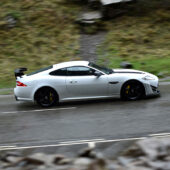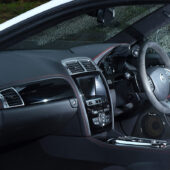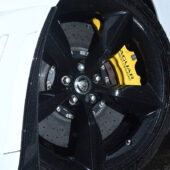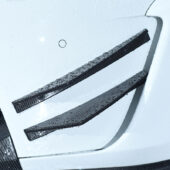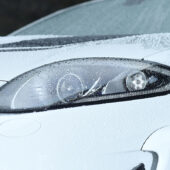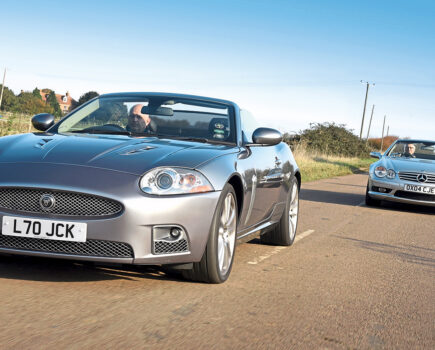The XKR-S GT was the final and arguably ultimate version of the Jaguar XK. We get behind the wheel
Words and images: Paul Walton With thanks to: Andrew Maynard, Swallow Independent Jaguar Specialists
THE BENDS arrive as quickly as they are sharp, a seemingly never ending series of left-right-left corners. Yet despite the constant changes in direction plus the terrible conditions that offer less grip than a pair of Crocs would in snow, the wide rubber plus extreme aero package help keep the car feel cool, calm and collected.
Not that I can say the same about me. Because to make it even more tricky, on either side is a rock wall that looks even less welcoming than a bank manager. One wrong move and I’d remove the nose like a piece of cheese on a grater.
A short straight section allows me to briefly bury the throttle and even though I’m using only a fraction of the engine’s massive power, the forcefulness of the acceleration still comes as a surprise especially in these tight and restrictive surroundings. A quick of dab on the brake pedal before changing down to third prepares me for the next challenge.
Regardless of what it sounds like, this isn’t a hill climb like Goodwood or Shelsley Walsh but the humble B3135 in Somerset. But with a three mile section running through the world-famous Cheddar Gorge it is one of the most challenging yet enjoyable roads in the country.
And neither is this a racing car but the final interpretation of the Jaguar’s once sensible grand tourer, the XKR-S GT.
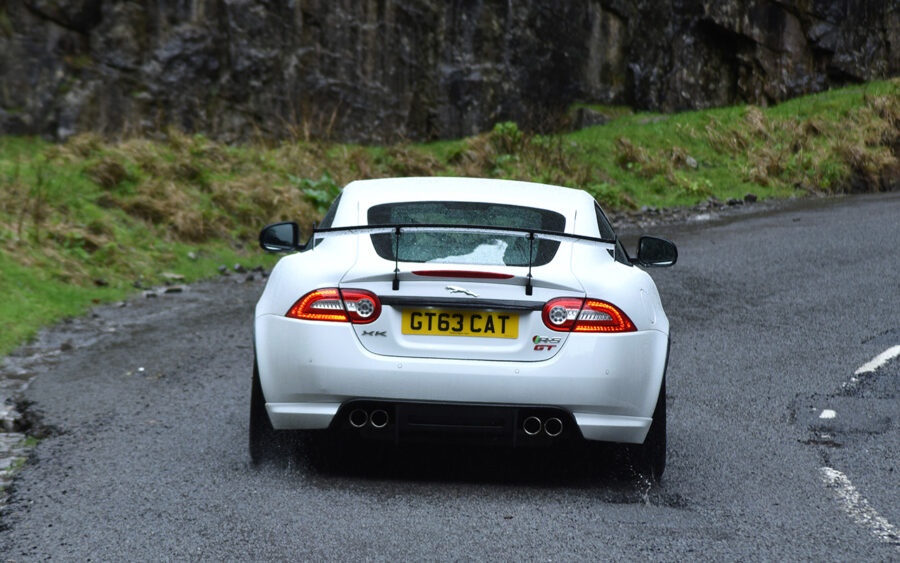
Coming just 18 months after the original R-S there was no one more surprised than me when the GT made its debut at the 2013 New York Motor Show. When I attended the UK launch for the XKR-S convertible in early 2012, I asked one of Jaguar’s engineers for vehicle integrity, Jeff Mitchell, whether it would be possible to make the X150 generation of XK go even faster. “As a GT car this is probably as far as you can go,” he said about the XKR-S in the March 2012 issue of Jaguar World magazine. “I think the next step would be a pure sports car and that’s a slightly different animal.”
Whether work hadn’t yet started on the model or he just couldn’t tell me but that’s what the GT is. The supercharged 5.0-litre V8 might have been left in the same 550PS state of tune as the R-S, but by weighing 40kg less than a standard XKR coupe plus many other updates to both the car’s exterior and suspension, the XKR-S GT was harder and more driver-focused than any previous version of XK.
“The XKR-S GT is the most extreme iteration of the Jaguar R Brand’s performance focus,” explained Adrian Hallmark, Jaguar’s then global brand director at the time of its debut. “Utilising race-car derived technology, all-aluminium construction and an uncompromised approach to aerodynamic efficiency, the result is a car as capable on the track as it is exhilarating on the road.”
The GT was the work of Jaguar’s Engineered to Order division, a forerunner of today’s SVO. It might have arrived close to production of the X150 generation of XK coming to an end, but it was still a comprehensive reworking of the now decade old car.
Jaguar’s design team created a package of carbon fibre aero aids which included a tall boot-mounted spoiler, a wrap around front splitter with vertical vents on either side, twin dive-planes plus a larger rear diffuser. Together Jaguar reckoned these produced 145kg (320lb) of downforce. There were also wheel arch extensions for the new 20in alloys plus louvres in the bonnet to aid engine cooling and reduce air pressure.
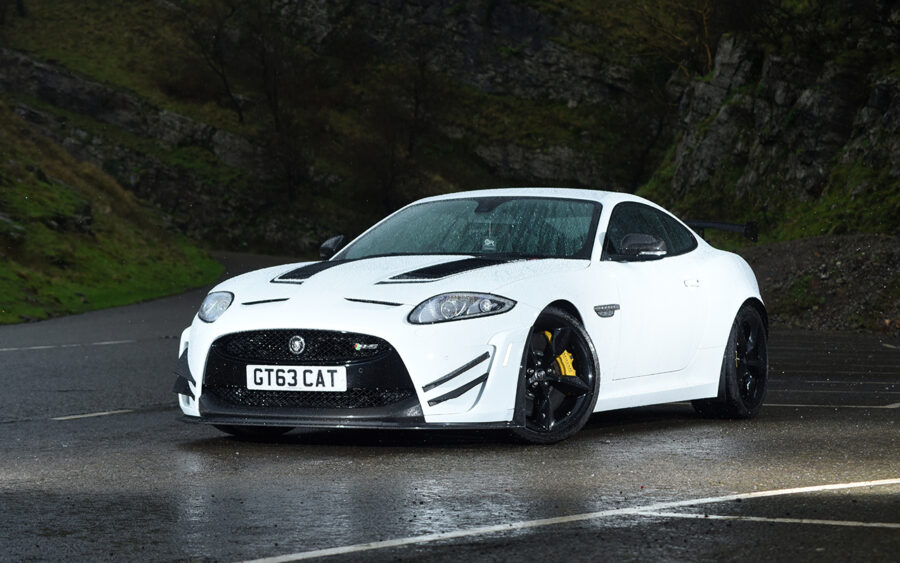
“The XKR-S GT has been designed purely by the laws of physics,” explained Jaguar’s then design director, Ian Callum. “It has been developed in the wind tunnel and on the racetrack with the sole aim of creating as much high-speed stability and downforce as possible. Nothing has been styled for the sake of it. It’s been an exercise in efficiency and the result is a car that’s raw, focused and devastatingly quick.”
The suspension was similar to that used by the F-Type and featured new front and rear suspension arms, uprights, wheel bearings, bushings and rear subframe, all of which had been designed to increase lateral suspension stiffness for greater responsiveness. Front and rear spring rates were 68% and 25% stiffer respectively than on those of the XKR-S, while the adaptive damping was retuned for less body roll. The front track was 52mm wider than that of the R-S while to increase the immediacy of the steering, a rack from the F-Type was again fitted but with a faster ratio and retuned valve.
Finally, the GT was the first production Jaguar to be fitted with a carbon ceramic braking system with huge 398mm rotors at the front and 380mm at the rear.
“The XKR-S GT is an uncompromised car, but one that inspires confidence and encourages the driver to push it to its limits, fully exploring its handling abilities,” said David Pook, the technical specialist responsible for the steering and handling. “It’s a car that draws you in and is never intimidating, with performance that is both accessible and rewarding.”
The result was a breathtaking car in both its looks and its performance. The top speed might have remained the same as that of the R-S at an electronically limited 186mph, but the dash to 60mph had been dropped by 0.3 of a second to a stomach churning 3.9. In a stroke, the once genteel XK suddenly had all the hardcore appeal of the Porsche 911 GT3.
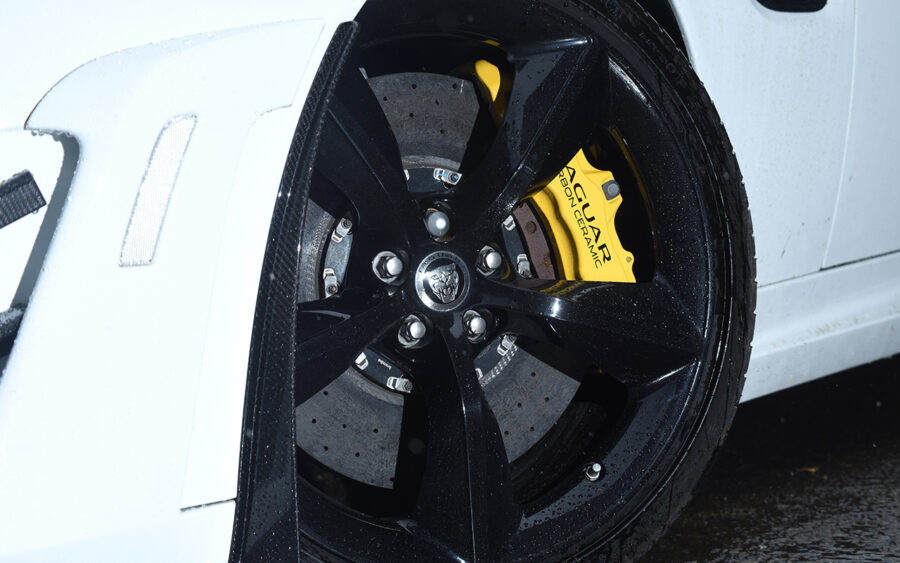
“With its huge rear wing, neat bonnet stripes and prominent front splitter, the GT is unlikely to be mistaken for any ordinary XK,” was Autocar’s thoughts in March 2014. “If anything, the Jaguar looks even more aggressive than its Porsche rival.”
The 911 GT3 was still ten seconds faster around the Nürburgring than the GT’s admittedly impressive time of 7 mins 40 secs. But as Pook said at the time, “We weren’t chasing the GT3. That’s not a performance level we were aiming at. Instead, we wanted lots of really exploitable performance.” They clearly achieved that.
Yet despite all the work than went into the XKR-S GT initially just 30 left-hand-drive examples (all coupes) would be built for the North American market. But due to heavy interest from this side of the Atlantic, Jaguar relented and produced another ten in RHD form for the UK priced at an eye watering £135,000, 30 grand more than the 911 GT3. It’s said a few more were also built for Europe and in total just 45 GTs were made between late 2013 and early 2014.
It makes the Polaris White example seen here (other colours included Italian Red and Ultimate Black) one of the rarest production models in the company’s long history; there are more C-types than there are XKR-S GTs. Owned by a customer of Swallows Independent Jaguar Specialist based outside Bristol, when I was offered a drive of this remarkable car I couldn’t say no especially since their workshop is close to one of my favourite roads.
Even when standing still, that massive wing, wide front splitter and huge 20in alloys give the GT a sense of urgency missing from all other XKs, as if its travelling at 186mph when stood still. Those two nostril-like vents at the front plus those air the side then make it look like some kind of mythical creature. All of this means the GT perhaps lacks the elegance of the original XK but that’s to be expected considering its high performance.

When I open the door and climb behind the Suedecloth-wrapped wheel, the interior has been left largely alone. Yes, there’s a strengthening cross member behind the front seats, yes the vestigial rears have been removed and yes there are now four-point harnesses as well as the more usable inertia reel seat belts but the general layout of the dash is identical to that of a 4.2-litre model from 2004. Even the dials are the same. But there’s no old-fashioned veneer like in those early cars, having instead more contemporary shiny piano black that’s as cool as the car itself.
The sports seats aren’t as awkwardly tight as those in other competition-orientated cars I’ve driven such as the Ferrari F40 that were so uncomfortable I was left with a limp for several days afterwards. Once grand tourer always a grand tourer I guess.
As I trundle towards Cheddar Gorge, it doesn’t drive like 86mph supercar either, the V8 feeling relatively docile considering the 550PS (544bhp) it offers. Even the clearly firmer suspension remains supple enough to soak up the worst imperfections in the road surface without transmitting them back into the cabin.
I eventually reach the village of Cheddar which considering the terrible weather is still busy with tourists who have come to see the famous limestone gorge that takes its name.
Lying on the edge of Mendip Hills, it’s the largest gorge in the UK and was formed by meltwater floods during glacial periods over the last 1.2 million years. Although the B3135 that runs through it will eventually take you deeper into the Somerset countryside, by following the same twisting, turning, sinuous contours as the gorge has resulted in one of the country’s best roads and the perfect test for a car like the GT.
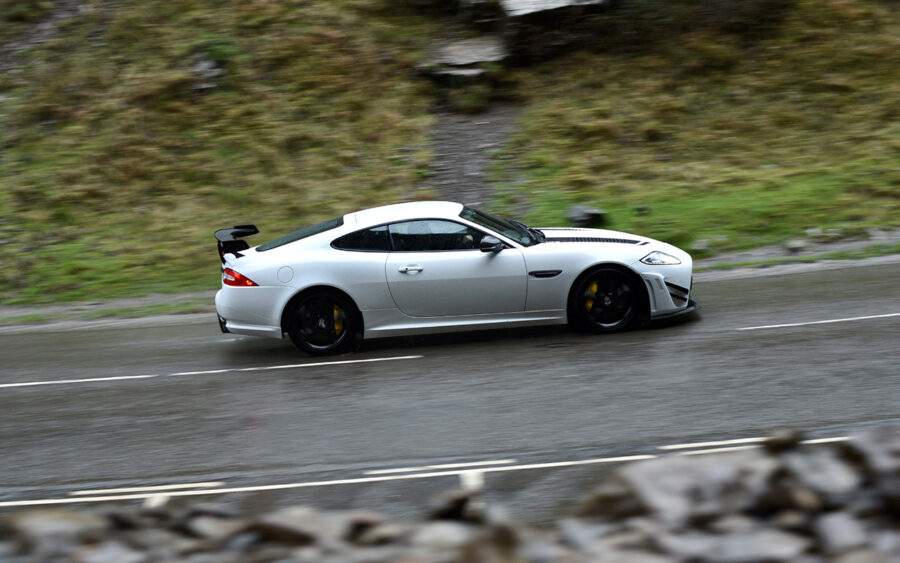
The gorge starts to tower above me as soon as I leave the village, reaching a maximum of 140m. As a former student of geology, I’m fascinated by the strata that criss-cross the cliffs like roads on a map but there’s no time to stop and study them. With the road ahead of me clear, I pull the left-hand steering wheel mounted paddle a couple of times to clunk the six-speed automatic transmission from fifth down to third before gently squeezing the throttle. With the engine primed like a firearm, the acceleration arrives with an immediacy that feels like it should be illegal for a road car, a hard, forceful and never-ending surge of power.
After backing off for a long corner I push the engine hard again for another short straight, the baritone rumble produced by the V8 ricocheting off the rock face on either side of me like gunfire. Used to loud Jaguars, the GT takes it to another level, a deep, dirty and deafening noise that can no doubt be heard in Bristol 20 miles away.
When the road in front of me is replaced by a hard and unforgiving looking rock wall, I brake hard and fast, the carbon pads doing a terrific job at scrubbing off speed. I throw the car into a tight left-hand corner, the cliff face on either tightening to barely a car width, making it uncomfortably tight to squeeze the big car through the resultant narrow gap.
The next section through the gorge is as exciting as any track or hill climb, an endless series of fast corners where the GT feels totally at home. The steering is sharp and accurate, more so than a standard XKR, while even under full load on a long right-hand hairpin there’s little body lean, the car remaining perfectly composed.
As I weave through the corners, my fingers become like those of a pianist on the paddles as constantly ask the six-speed ‘box to change either up or down. Clearly an old unit compared to the modern eight-speed transmission fitted to the current F-Type R, but it’s still relatively fast, reacting the moment I ask for another gear.
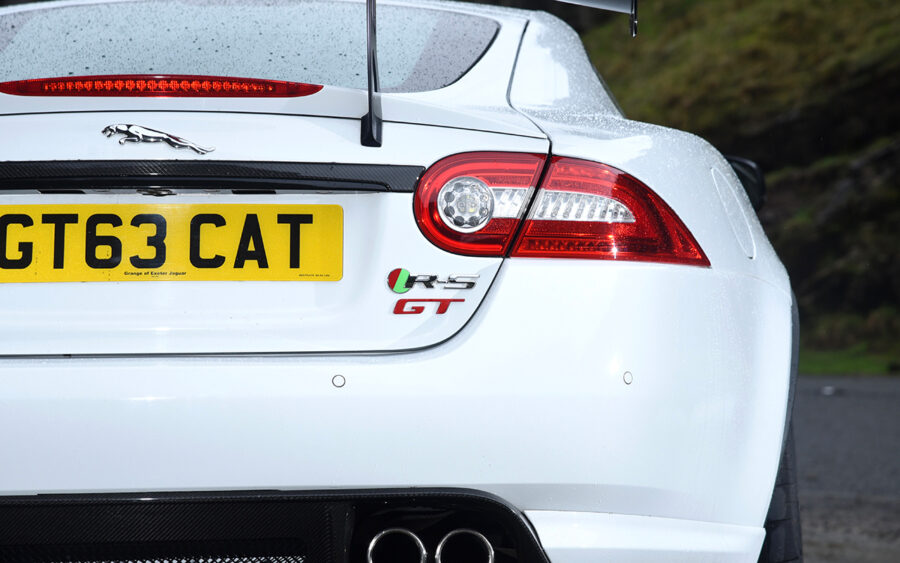
With gap between the cliff face narrowing again, I instinctively back off. Even with the front splitter and rear spoiler trying to push the car down plus the usual array of modern driver aids stopping me from getting into trouble, I’m well aware if I’m too heavy with the throttle the car will snap away faster than I could correct it and like that strata I saw earlier, I’d become a permanent fixture of Cheddar Gorge.
Thankfully, the gorge soon starts to widen and with the road straightening a little I’m confident for one final burst of speed before reaching the end of the gorge. The cliffs on either side of me now are lower and covered in trees resulting in a softer and more welcoming view.
The section of the B3135 through Cheddar Gorge might be just three miles long, but it’s as exhilarating as any hill climb but with an added sense of danger the likes of Goodwood misses out on due to the unforgiving rock face that’s never far away.
Although on paper it’s not that much faster than the XKR-S, what I find most remarkable about the GT is how Jaguar’s engineers managed to give this relatively old grand tourer a second lease of life, finding within it a harder, more driver focused sports car. Its more like the later F-Type SVR from 2017 than the standard XK 5.0-litre models never mind the early 4.2 cars. Yet by retaining a little of the original’s grand tourer origins, the XKR-S GT is also more usable and comfortable than its considerably harder V8-engined sibling.
The XKR-S GT might have taken everyone by surprise but the fact this large and luxurious grand tourer could to be transformed into a genuine sports car yet with a comfortable edge shouldn’t have been.





